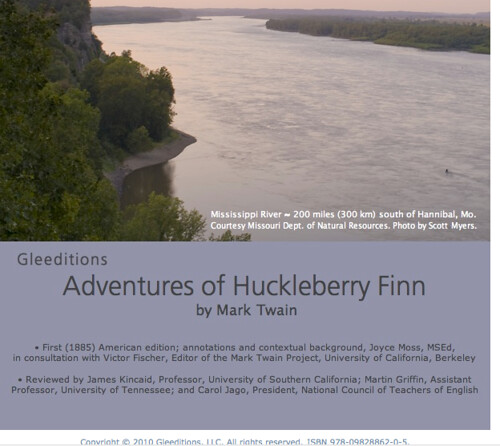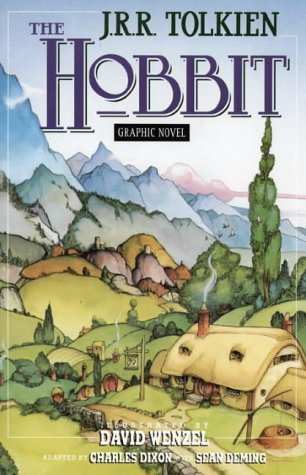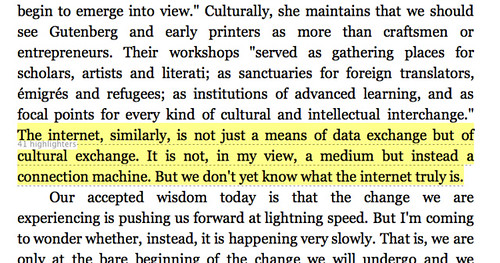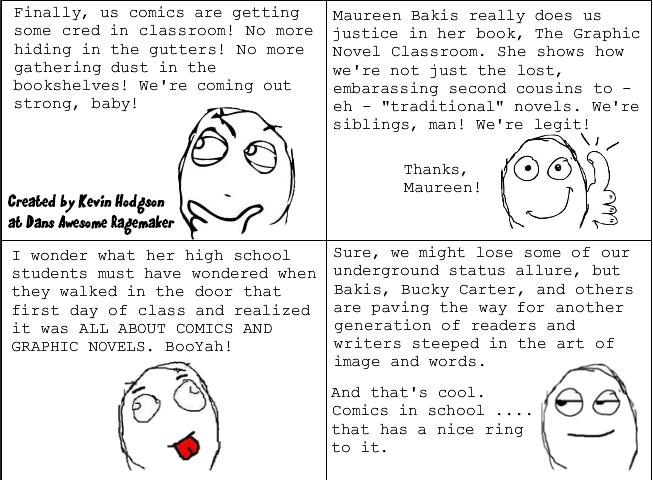
I saw this via my NCTE connections. In honor of Banned Books Week, a company has put out for free its annotated version of The Adventures of Huckleberry Finn. While the design of the annotated text isn’t all that great (particularly in a Kindle/Nook/iPad world), there is a lot of useful background information at the start, and you can activate various color-coding systems for things like voice, plot, style, point of view and more.

It might be a nice way to show (maybe on a whiteboard) all of the ways that an author gets at a story, but also, to talk about why this book and others ruffle so many feathers, and end up from time to time on the banned book lists of communities.
There is also this video about Banned Books, which is part of a video playlist from Video Amy over at Edutopia.
Peace (on the pages),
Kevin
Category Archives: books
Graphic Novel Review: Tune (Book 1 – Vanishing Point)

Loaded with references to Star Trek and Star Wars and plenty of comics that have come before it, Tune by Derek Kirk Kim is a fun graphic read in which the main character — Andy Go — is at a dead end with his life dream of becoming an illustrator and gets talked into becoming an exhibit at a zoo in a parallel universe. Talk about job opportunity! Much of this first book centers on the character of Andy, who loves a girl who may or may not like him back, battles his parents who demand that he get a job or move out of their house, and is a bit frustrated with his own vision of art.
Derek Kirk Kim has created an interesting character in Andy Go, and the interdimensional creatures that come to recruit Andy for his zoo at the end of the book have a lot of slapstick possibilities. This graphic novel nicely mixes science fiction and comedy, and while never taking itself too seriously, the story does have a solid emotional center around Andy and his own insecurities about life and the dead ends that seem ahead of him.
And Kim keeps the story going at his online site — Tune — where you can also read the entire first book (which I am reviewing) as well as the second book that he published online. How cool is that? Pretty darn cool. This book would be fine for high school students (some profanity), but not so much for middle and elementary students.
Peace (in the other dimension),
Kevin
eBook Review: Gutenberg the Geek

It’s not hard to think: that Johannes Gutenberg really changed the world. The use of the moveable type printing press suddenly made books more available than ever, opened the doors of literacy to more than a small, select group, and set the stage for various revolutions that took place once data and information began to flow. In Gutenberg the Geek, Jeff Jarvis seeks to understand Gutenberg as a man of his time, but also as a foreshadowing icon of the current age of technology, where innovation, hardship, luck and the ability to pull together disparate ideas into one large concept are shaping the environments in which we work, learn, and live.
“Our accepted wisdom today is that the change we are experiencing is pushing us forward at lightning speed. But I’m coming to wonder whether, instead, it is happening very slowly. That is, we are only at the bare beginning of the change we will undergo and we cannot yet fathom its full shape and extent.”
Jarvis, Jeff (2012-02-27). Gutenberg the Geek (Kindle Single) (Kindle Locations 239-241). . Kindle Edition.
In this book, Jarvis tracks some elements of Gutenberg’s life as a businessman, and a printer, showing some connections to various tools of social media and the Internet itself. His aim to create echoes from the past, with Gutenberg’s ideas around information flow altering the way the world worked, to today, where things are still very much in flux, and unknown. Living as we do in “the moment,” it’s hard to know for sure what the Internet and technology will end up doing to us as information gatherers and creators. If we look back to Gutenberg, it’s clear that seeds get planted when information is cut loose from the narrow few (publishers, etc.), but what kind of flowers and weeds will bloom won’t be known until historians look back.
And Jarvis concludes his fascinating piece with these words of warning and possibility:
“I believe the internet could prove to be as momentous an invention, as profound a platform. This is why we must protect the net from the control of governments and corporations — especially because they are the objects of the disruption technology enables. Only if it remains as open as the printing press for anyone — no, everyone — to use can the net realize its potential and can we realize ours.”
Jarvis, Jeff (2012-02-27). Gutenberg the Geek (Kindle Single) (Kindle Locations 298-301). . Kindle Edition.
Peace (in the geek),
Kevin
Reading in the Shadows of Strangers: On Shared Highlighting
Like many of you, I am sure, I remember saving money in college by buying used books. I really hated the concept of using someone else’s books for class because I always wanted a pristine copy of the textbook or novel that I could mark up as I saw fit. Instead, I had to deal with someone else’s version of main ideas and interesting points highlighted in (mostly) yellow, and I was always distracted by those markings by the past owner. Did I agree with their marking? If I didn’t, was I missing something? I found myself reading in the shadows of strangers, trying to make my own observations and connections whole in some invisible conversation with someone else.
I was thinking about this again as I (late to the game, I realize) began to use my Kindle App on my Mac to read ebooks. I like Amazon’s collection of short pieces just for the Kindle, but I don’t have an eReader device. So I read on my laptop (which is not quite the same thing as snuggling down on the couch — so the reading experience is not nearly the same but still …). I hadn’t quite counted on a feature that seems completely logical given our connected culture, but it still has me remembering those college textbook days: the notation feature that shows how many other readers of my eBook have highlighted specific passages in the same ebook. (It also reminded me that the ebook that I buy is still part of the Amazon infrastructure, and not really sitting there in my Kindle App. Which is odd to think about, right? Do I really own this book or not?)
For example, I am now in the midst of Gutenberg the Geek by Jeff Jarvis. One section that I highlighted was also noted by 41 other readers before me.
And so I am left with the same conundrum that I had in college: I am interested in what other folks find interesting, and yet, I find myself reading those passages very differently — almost out of context from the whole. When a certain sentence has a few dozen highlighters affixed to it, I wonder: what is so important about that particular sentence that so many people added some color to remember it? I also wonder, did the first person highlight it for a specific reason, and then the next reader comes along, and say, “that must be important, I’d better highlight it, too,” and then the layers of highlighting grows from there, as if we were are reading-lemmings? Are we all being influenced by the readers before us? By the very first reader of this book to click on the highlighter?
I assume I can turn the shared highlighter off somewhere in my app, but I haven’t done that yet. That’s because I am still uncertain about how I feel about having it there. On one hand, it makes reading feel like a collaborative journey. My highlighting will be part of the ongoing narrative of this text for the next and future readers. I am not alone. On the other hand, I am unsettled by having other voices in my head as I read, pointing me to things that might be important to them but not to me.
No doubt, the emergence of eReaders and the tools that come with them are intriguing and unsettling at times, and completely fascinating in a range of ways.
Peace (in the highlights),
Kevin
eBook Review: Why School?
I’ve long been a huge fan of Will Richardson. One of his earlier books — Blogs, Wikis, Podcasts and Other Powerful Web Tools for the Classroom — helped shape my own thinking about the practicality, practice and the pedagogy of integrating technology into my classroom in meaningful ways. I’ve passed that book along to many a teaching friend, and I continue to read with interest any of the blog posts and magazine columns that Richardson puts out. So, I was intrigued by his newest ebook, Why School? How Education Must Change When Learning and Information Are Everywhere.
Richardson writes in a clear and passionate voice in this book about the need for schools to make the shifts necessary for young people to become engaged in learning with the world and to set establish educational goals that make sense in their lives. Standardized testing? Not so much. In Why School?, Richardson keeps the message mostly positive, acknowledging the difficulties that educational leaders are having in coming to grips with the surprisingly fast pace of change in the world due to informational explosion and connectivity. His central term and idea here is “abundance” — as in there are information sources all over the place, accessed from many different devices and points and time by many people, and it is more important to be teaching our learners how to navigate and access that abundance than it is to drill/kill them on facts that can be easily found with a simple search engine query.
“Remaking assessment starts with this: Stop asking questions on tests that can be answered by a Google search.”
Richardson, Will (2012-09-10). Why School?: How Education Must Change When Learning and Information Are Everywhere (Kindle Single) (Kindle Locations 331-332). TED Conferences. Kindle Edition.
He makes it clear that we shortchange our children when we don’t use all available means to:
- reach out the expertise in the world ready to help young people learn (scientists, mathematicians, etc.)
- learn as teachers along with our students and make that learning visible
- develop authentic activities with real goals where skills are transferable to multiple areas
- use technology and media wisely, and for creating and connecting
- tap into the surprisingly dense literacies of our students (ie, gaming, etc.)
There are any number of passages that I highlighted in the book, and here is one that stuck out for me because it reminds us to ignore that old dichotomy of native/immigrant, and understand that teachers are needed as never before:
“Access doesn’t automatically come with an ability to use the Web well. We aren’t suddenly self-directed, organized, and literate enough to make sense of all the people and information online — or savvy enough to connect and build relationships with others in safe, ethical, and effective ways. Access doesn’t grant the ability to stay on task when we need to get something done. No matter how often we dub our kids “digital natives,” the fact is they can still use our help to do those things and more if they are to thrive in the abundance of their times.”
Richardson, Will (2012-09-10). Why School?: How Education Must Change When Learning and Information Are Everywhere (Kindle Single) (Kindle Locations 169-173). TED Conferences. Kindle Edition.
Want more? You can also see the interview that Richardson did over at the blog for TED (which is a publisher of Why School?) If you are interested in what shape schools should be taking (as opposed to the shape they are taking, influenced mostly by the business community and education textbook establishment), then Richardson is someone to listen to and his message is something to think about, and act on.
Peace (in the sharing),
Kevin
Graphic Novel Review: The Hobbit

So, apparently today is “Hobbit Day,” celebrating the imaginary shared birthdays of Frodo and Bilbo Baggins. In honor of this day (ahem), I figured I should get around to writing a review that I meant to write over the summer. I read The Hobbit as read-aloud to my (now) 8 year old son (and then we got bogged down in Lord of the Rings trilogy), and he completely and utterly loved the story. After we ended the book, I found a graphic novel version in our local bookstore, and my son has had it in his room every since (which is why I kept forgetting to write a review of it).
I’m pretty sure there are a couple of graphic interpretations of the classic Tolkien novel but this one by illustrator David Wenzel (and adapted by Charles Dixon and Sean Deming) is pretty well-done and faithful to the original story, while moving it all in a very visual direction. The graphic novel covers the entire story and while it is a bit text-heavy (as if everything Tolkien — see my note above about getting bogged down in Lord of the Rings), this graphic interpretation is a wonderful companion piece to the book. I’m glad we read the book first, but my son made a great transition from the power of the read aloud (his own imagination) to the graphic novel version (someone else’s imagination) and we had some long discussions about the way Wenzel envisioned characters, scenes, etc.
What I like best is that the story has remained with my son over the months because the graphic novel is such an easy interface — he connects back to the story with the illustrations. I don’t think he reads all that much of the text in the graphic novel, but that is one of the powers of the graphics — the illustrations tell the story. And now we wait for the movie to start coming out, and he has repeatedly asked if he is old enough to see it. I think it will be one of those movie adventures that the two of us (we may even allow an older brother to join us) can experience over the next few years as the parts of The Hobbit movie come out.
But for now, Happy Hobbit Day. May you go wandering into adventure every day, and still find your way home.

Peace (in all the earths),
Kevin
PS — this is a pretty decent celebration post of The Hobbit at Wired Magazine.
Book Review: Just My Type
I wasn’t sure what to expect with this book by Simon Garfield. But Just My Type, which looks at the world of font typesetting (yep – you read that right), is a fascinating look at how the way our letters and words look impact what they mean. There’s a history of typesetting and font creation here — from Gutenberg on to the present — and Garfield takes a number of side exits to look specifically at some styles of type and their founders. This book makes clear just how much artistry and work goes into the things most of us take for granted and how the aim of designers to make their work invisible to the average reader.
I’m developing a resource over at the National Writing Project’s Digital is site around font and writing — inspired by reading Garfield’s book — so I won’t get too much into the ways this topic might have us think about writing and design in new ways. Still, for what could be an arcane topic, Garfield’s lively writing and ability to explain font architecture to the layperson (me) made for a thoroughly enjoyable read.
And I know longer look at public signs on display and other kinds of writing the same way, either. Now, I think: what is the writing itself trying to convey? That’s the power of fonts.
Peace (in the font),
Kevin
Podcast Poem: Words Under Water (or the Drowned Font)
I’ve been reading the book Just My Type that looks at fonts, typesetting, and the ways that lettering changes our perceptions as writers and as readers. It’s pretty fascinating and I will explore more on another day. But one story stood out — that of a creator of typeface who fell out with his partner, and before he died, he dumped all of the moveable type of the font into the river in order to destroy it rather than give it over to his partner. I wondered about those letters, and those words that might come of them, and this poem came from that.
Words Under Water (or the Drowned Font)
Imagine
if you will:
words under water –
letters culled together by the ocean’s pull
as heavy metal type, cast off from a London bridge,
re-assembling themselves seamlessly into stories no one will ever hear
or read,
and yet filling up countless pages that get turned by the currents
every single day
in a font lost forever
by the jealousy of its creator
whose only goal as his sunset days ended
was to destroy the words
by drowning.
Peace (in the forgotten font),
Kevin
Book Review: The Night Circus
There are books about magic, and then, there are magical books about magic. The Night Circus, a debut novel by Erin Morgenstern, is one of those novels that has such beauty and mystery and magic of many kinds shifting in and out of the narrative that I had trouble putting it down, and that was a problem because school was starting and my brain was needed elsewhere. Still, I snuck in my reading moments.
I notice a lot of reviews of The Night Circus fluctuate between disappointment and rapture. It seems the disappointment comes from the book jacket overselling the “competition” between two magicians when what this really is is a love story between two students of master magicians whose lives have been put into “play” in mysterious ways. The circus itself — a black-and-white themed, ever-expanding affair that arrives and leaves without notice — is the backdrop for all that unfolds here in this story.
I’m reluctant to give away too much, except that for a new novelist, Morgenstern does a fantastic job of balancing the use of magic in underlying ways (there’s not blasting of wizards from wands or any of that) and building up a real sense of wonder as multiples narrative threads come together. And the ending, where a conversation between two characters about the role that “stories” play in our lives, and how they weave magic for all of us, grabbed me at once and brought me right into why I love novels so much, and how transforming good writing and powerful stories can be. Given what came before in the novel, it was a perfect way to end.

Peace (in the night),
Kevin
Middleweb Book Review: The Graphic Novel Classroom
I had the pleasure of reviewing a book — The Graphic Novel Classroom by Maureen Bakis — for the Middleweb website (which is a fantastic resource for middle school teachers). Bakis does an excellent job of showing how graphic novels and comics can have a place in the high school curriculum. (The comic above was my addition to my review. I figured it made sense to have a companion piece to the writing, given the subject matter.)
Peace (in the review),
Kevin


